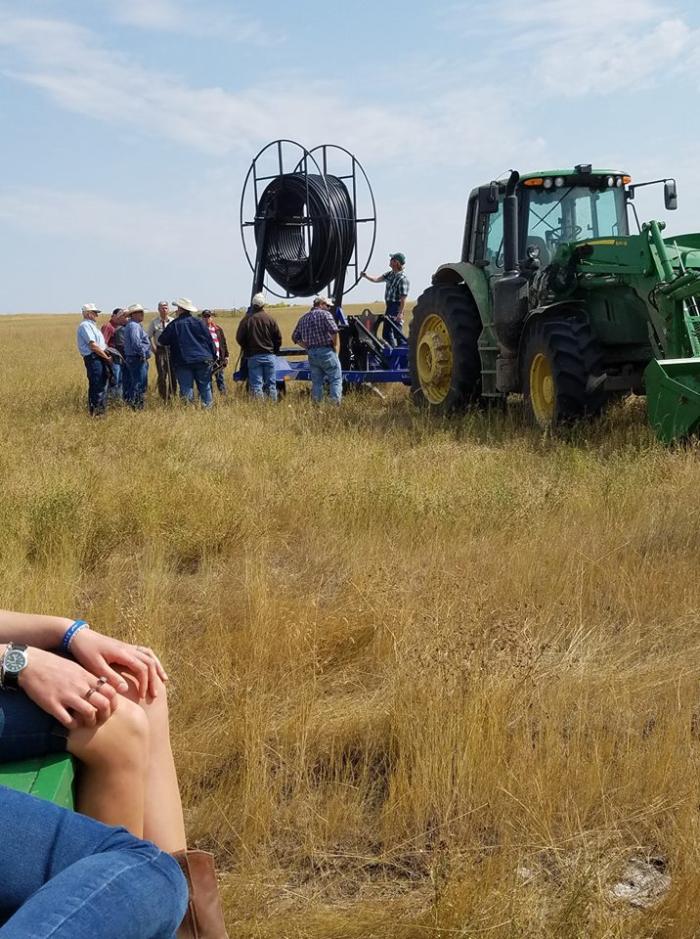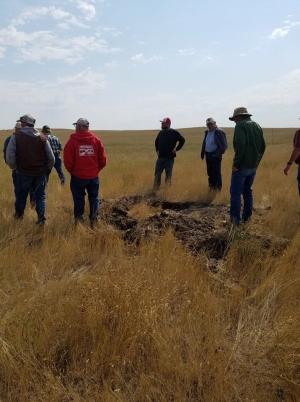A Work in Progress in Williams County
As Bruce Brogger transitions the next generation into the family ranch operation, he’s even more aware of the importance of soil health and its effects on range management.
Luann Dart writes from Elgin, N.D.
Third-generation ranchers in the Williston area, Bruce and Kathleen Brogger are transitioning their daughter and son-in-law, Justin and Sara Loomer, into the commercial cow/calf operation. To help plan for the future, the family has been developing pastures for rotational grazing.

“We’ve been playing with rotational grazing for a few years, but this year we got more serious about it,” Bruce said. And he’s been utilizing incentive programs through the Environmental Quality Incentives Program (EQIP) of the Williams County Natural Resources Conservation Service (NRCS) to put a rotational grazing system in place.
“NRCS has worked with Bruce and Kathy since the early 1990s. They have always shown interest in trying innovative practices on their ranch. Since Bruce claims he is not a farmer and would much rather ranch, they decided to seed all their cropland back to grass. NRCS assisted them on grass seedings, and developing fresh water systems, cross fences and grazing systems,” said Scott Nordloef, Williams County NRCS Soil Conservation Technician.
In the 1990s, the Broggers put every acre possible into the Conservation Reserve Program (CRP), transitioning about 380 acres of cropland into the CRP.
“We get into some of that rough country. The soils really aren’t great farming soils,” Bruce said. “We put everything that didn’t interfere with our livestock operation into CRP.”
The ranch then used the EQIP program to place more than four miles of shallow and deep-water lines to those areas to use as winter grazing. The Broggers also installed 11 water tanks along those lines to spread out the grazing.
“We’re still a work in progress,” Bruce said about the possibility of placing more water lines.
At the same time, all the pasture acreage was seeded with crested wheatgrass, alfalfa and a mix of other grasses to promote early grazing on that land.
Some pastures have now been seeded with meadow brome and alfalfa and then divided into paddocks. About 70 cows and a handful of yearlings were placed on 40-acre paddocks initially, but Bruce didn’t feel there was enough even impact on the pastures, so the pastures were split again.
Paddocks now include three groupings of pie-shaped formations of 13-acre paddocks, along with to larger sizes of paddocks. Cattle are rotated daily on the smaller paddocks and every three to four days on the larger paddocks.

For the smaller paddocks, Bruce is using 1/16th-inch cable as temporary fencing.
“That conducts [electricity] better and the cows tend to respect it more,” he said.
The rotational grazing as already had effects on both the land and livestock, Bruce said.
“I think our grasses are getting better. The stands are improving,” he said. “Our cows are looking really good when they came off of that.”
Cattle will graze the paddocks through the summer, then are moved into the large, rough pastures into November. After weaning, the cattle are moved into an area for winter bale grazing.
On a 40-acre CRP area, 100 bales are placed, in rows of 10 bales each, with temporary fencing placed between the rows. As cattle graze through the rows of bales, the fencing is lifted. Portable windbreaks offer protection and tire tanks with insulated covers and a tank heater if necessary provide water.
“You don’t have to start the tractor every day,” Bruce said with a laugh, describing the main benefit to winter bale grazing.
After the first winter of using bale grazing, Bruce was surprised at how little residue was left in the area.
“I was shocked after it had been hayed and there was very little residue. There was no sign of the residue,” he said.
In 2005, the Broggers were chosen as the Williams County Soil Conservation District Achievement Award winners due to their exemplary conservation efforts. Bruce currently serves as a supervisor for the Williams County Soil Conservation District.
“He helps find new ways to improve soil health on cropland and rangeland throughout Williams County,” Nordloef said.
Bruce appreciates the assistance of NRCS in helping the ranch improve soil health and reduce inputs.
“The financial help, along with the labor and expertise from the NRCS crew from the start of our projects, helped us get on the way to improving our soil health and productivity,” he said.
The Broggers have attended many seminars on grazing systems and are always looking for new ways to better their operation. In the fall of 2018, the Williams County Soil Conservation District hosted a range tour at their ranch. Bruce and Kathy, along with their daughter, Sara and son-in-law Justin, opened their operation for others to learn more about the benefits of planned grazing systems.
“They have done a very good job with their operation. I have learned a lot from the Broggers and others who were there along the journey. They are the reason I have enjoyed my job throughout the years.” Nordloef said.

